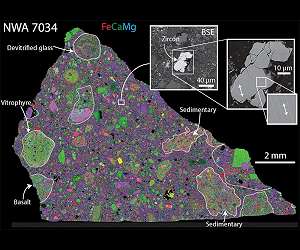Monash University, University of Queensland and Australian National University researchers have used ANSTO’s Australian Synchrotron in their study of meteorites found on Earth that could be used in future to find evidence of life on the planet Mars.
The examination of meteorites recovered from the Nullarbor Plain in western South Australia by a joint team that included Dr Andrew Langendam from the Australian Synchrotron contained organic residues in the form of microfossils preserved in mineral veins within the dense rock.
“It has been an established site for finding meteorites since the 1980s. The dark iron-rich meteorites stand out against the white limestone and red soil of the plain, ” said Dr Langendam. Link to video
The research revealed that a variety of fossil microorganisms, diatoms, bacteria and fungi, were entombed and preserved within veins of calcite and gypsum.
X-ray fluorescence microscopy at the Australian Synchrotron supervised by instrument scientists Dr Jessica Hamilton (then a PhD student at Monash) and Dr David Paterson, both co-authors, confirmed that redox-active metals, such as manganese and iron, were mobilised in vein-filled cracks within the meteorite by environmental or microbial activity.
“The location and quantity of calcium, iron and manganese can be delineated in the sample by the ultra-sensitive technique. It revealed that the manganese enrichment occurred at the rim of calcite-gypsum veins,” said Dr Hamilton.
The research team noted that meteorites could preserve a suite of microfossils, organic biosignatures and records of nutrient cycling under the arid conditions on the Nullarbor.
Co-lead author on the paper published in Geochemica et Cosmochemica Acta and Frontiers in Microbiology, Dr Alastair Tait from Monash University’s School of Earth, Atmosphere and Environment, said in a news report on the Monash website, “This is an original finding and it is important because it shows us that microorganisms can interact with astro-materials in a way that is vital to their metabolism.”
Co-lead author Prof Gordon Southam of the University of Queensland’s School of Earth and Environmental Sciences said in a news report on the UQ website, “This adds a new dimension to the search for life on Mars, targeting comparable meteorites on the red planet.”
“Essentially, they provide a time capsule of past biological activity, or, in the case of samples from the Nullarbor Plain, meteorites can serve as a refuge for life,” said Prof Southam.
“They act as lifeboats for life on a hostile surface, where there are not many bioavailable minerals,” said Dr Langendam.
Mars has an extreme environment compared with Earth. The temperature on the desert-like surface of the Red Planet is approximately -62 degrees Celsius. Its atmosphere is very thin and made up of 96 per cent carbon dioxide. The atmosphere of Mars is far less dense than the atmosphere of Earth, with inhospitable low atmospheric pressure.
“By studying how meteorites on Earth are altered by weathering and microbial activity, it may help to know what chemical signatures to look for when we study the same meteorite material that fell on Mars, which could have been weathered and potentially altered by any life there. Looking at meteorite chemistry as an environmental record, and as a potential way to compare processes on Earth and other planets, is a new idea and really exciting,” said Dr Hamilton.
Although the Martian landscape has been studied by a series of exploratory vehicles, including the most recent Perseverance Rover, no actual samples from the planet’s surface have been returned to Earth as yet. The samples are analysed by instruments on the surface.
The research team suggested that samples returned from Mars will be used to build an overall picture of the volcanic and sedimentary history of Mars, in which past life might be preserved.
Research Report:Evaluation of meteorites as habitats for terrestrial microorganisms: Results from the Nullarbor Plain, Australia, a Mars analogue site
Related Links
ANSTO
Mars News and Information at MarsDaily.com
Lunar Dreams and more
|
We need your help. The SpaceDaily news network continues to grow but revenues have never been harder to maintain. With the rise of Ad Blockers, and Facebook – our traditional revenue sources via quality network advertising continues to decline. And unlike so many other news sites, we don’t have a paywall – with those annoying usernames and passwords. Our news coverage takes time and effort to publish 365 days a year. If you find our news sites informative and useful then please consider becoming a regular supporter or for now make a one off contribution. |
||
|
SpaceDaily Contributor $5 Billed Once credit card or paypal |
SpaceDaily Monthly Supporter $5 Billed Monthly paypal only |
|

![]()
Shocked zircon find a ‘one-off gift’ from Mars
Perth, Australia (SPX) Feb 04, 2022
Curtin University researchers studying a Martian meteorite have found the first evidence of high-intensity damage caused by asteroid impact, in findings that have implications for understanding when conditions suitable for life may have existed on early Mars.
Published in leading journal Science Advances, the research examined grains of the mineral zircon in Martian meteorite NWA 7034. The meteorite, colloquially known as ‘Black Beauty’, is a rare sample of the surface of Mars. The original 320-gr … read more